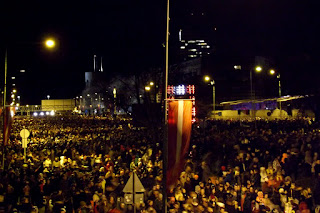Each 11th november on Latvia is celebrated Lāčplēša Dayin honour of the main latvian which fought for an independent state. Lāčplēša is the name of a latvian hero where you can read the epic tales recovered by the XIX writer Andrejs Pumpurs (yes, and he was romanticist, that´s why he recovered the tales of a mythological hero) but in this case for Lāčplēša we mean the latvian militant arm that fought during an Independence War that took 2 years...or almost 3 if we count the time until signing the peace and independence recognition by all the active sides: Latvia, Germany and Russia and a very important battle that came on january 1920 on latvian soil: the Battle of Daugavpils, where Poland´s state was also on risk by the Soviet menace- Besides, Latvian War of Independence could be considered as an episode of the Polish-Soviet War episode that took over from 1919-1921 on North-East Europe (this includes all Baltics).
The Lavian War of Independence took place on latvian territory and made local siege in the years 1918-1919 and the last day of sheded blood was on 11th november 1919, when the main russian army that was participating in this war, the West Russian Army was ultimately defeated by the Latvian Army in the east part of Latvia.
A bit more of history:
Right World War I was over two of the main european powers put their eyes of Baltic land:
From the east side, the newly formed URSS, which its main and massive Red Army. Right after the proclamation of the Soviet Union Russia began an expansion to the west to make its territory and political ideologies greater and wider. Russia was the first to strike in this conflict, coming from the east and in just one month most of Latvia was invaded by the Red Army.
From the west side, the German Empire, badly defeated on economical terms because WWI but still strong enough to perfectly crush small armies and annex small states. The German Empire still yearned the prussian years and didn´t recognize an own latvian goverment.
But actually, either Soviet Russia and German Empire on Baltics was acting in some battlefronts, surprisingly, under a same banner: The West Russian Volunteer Army, officially russian but unofficially german. The why of this alignment came from the inners of this army: actually, Germany was provided by russian POWs whereas these prisioners where promised to be set free by Germany for the current Russian Civil War.
With this, we could say that we had a triple-cross war, where it could be taken over if planned properly; of course, this meant the help for the remaining latvian state from countries such Estonia, Poland, the British Empire (with a powerfol Royal Navy battelship harbored on Riga´s docks) and France.
But anyway, the West Russian Volunteer Army was the main enemy to face for Latvia (thus meaning that it was basically fighting against Germany and Russia in a same paty) and this invader took an overwhelming attack that would ultimately push out latvian´s independent goverment with a siege to Riga, the capital city of Latvia. This siege took one month of time and for this time Latvian Army had the aid of the Royal Navy cannons and the Estonian supplies...but still, Latvian Army was too "weak" to face such a powerful and vast army like The West Russian Volunteers (called on this siege "Bermotians", due the main commander head on this operation was the russian warlock Pavel Bermondt-Avalov), which had a great number of war machines.
This last battle was specially crude but in the end, on 11th november, the Bermotians fled from Latvia defeated, meaning the victory of Latvia and its peace reform. After this event, example of how a keen David thrown out a badly organized Goliath, Latvia lived its most shining and glorious years.
So this it, Lāčplēša was the name for the main freedom fighters that struggled on Latvian War of Independence and 95 years later they are still condecorated by most of Latvia´s citizenship as symbols of patriotism, heroism and, not least, freedom.
On Valmiera, there was a brief speech on Saint Simon´s Church (main lutheran church on the town) for this day and later a parade from the church to the town´s cemetery (basically, crossing all the town) holding torches, candles, flowers and latvian flags, being these 4 things the main symbols of this day and next ones. Must be said, but during these days of november in all Latvia there will be events to celebrate this history, where the climax will be the next 18th november, where in Riga there a closing show of beautiful fireworks on Daugava River! These are the Independence Days!
First of all, at 17:00 there was a church´s ceremony. Notice the latvian flag behind the priest.
These are the verses read during the church´s event.
Front of the parade notice the UFO at upper right of the picture...just joking.
As said, several elements are portrayed on this day, but torches play the main role.
Yes, is this long.
The candles doing its role, all them are red or white,
Yes, is thiiiiis long!
The parade finish in the town´s cemetery, in the field where the fallen during Latvian War of Independence rest.
Once there, several speeches taken by some personalities such the mayor, the priest and a commander are pronounced. And some songs are sung as well. Flowers and candles are left in the tombs and in the main sculpture.
The cemetery receives the gleaming warm flame of the successors.





















































